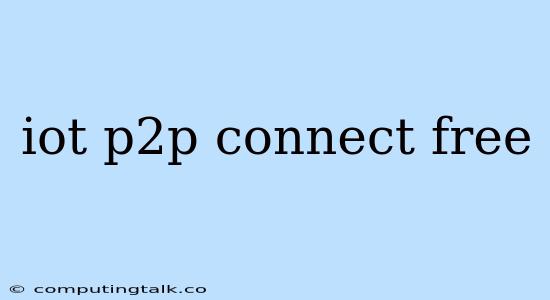The internet of things (IoT) is rapidly changing the way we live and work. With billions of devices connected to the internet, there is a growing need for secure and reliable communication between these devices. Peer-to-peer (P2P) communication offers a promising solution for connecting IoT devices without relying on a central server. In this article, we will explore the potential of P2P communication for IoT applications and discuss the benefits of using free P2P platforms.
What is P2P Communication?
P2P communication is a decentralized approach to networking where devices can directly connect to each other without going through a central server. This allows for more efficient and secure communication, as data does not need to be routed through a central point. In the context of IoT, P2P communication can be used to connect devices within a local area network (LAN) or even across the internet.
Benefits of P2P for IoT
There are several benefits of using P2P communication for IoT applications:
- Reduced Latency: P2P communication can significantly reduce latency, as data does not need to be routed through a central server. This is particularly important for real-time applications, such as sensor networks and industrial automation.
- Increased Security: P2P communication can be more secure than traditional client-server communication, as data is not transmitted through a central point that could be vulnerable to attack.
- Scalability: P2P networks can be easily scaled to accommodate a growing number of devices without requiring significant infrastructure changes.
- Reduced Costs: P2P communication can reduce costs by eliminating the need for a central server and its associated infrastructure.
Free P2P Platforms for IoT
Several free P2P platforms are available for developers to use in their IoT applications. Some popular options include:
- MQTT (Message Queue Telemetry Transport): MQTT is a lightweight messaging protocol designed for constrained devices and networks. It is widely used in IoT applications and supports P2P communication.
- WebRTC (Web Real-Time Communication): WebRTC is a technology that enables real-time communication between web browsers. It can also be used for P2P communication between IoT devices.
- ZeroMQ: ZeroMQ is a messaging library that provides a variety of communication patterns, including P2P communication.
Challenges of P2P in IoT
While P2P communication offers numerous advantages for IoT, there are also some challenges to consider:
- Device Discovery: Devices need to be able to discover each other in a P2P network. This can be challenging, especially in large and complex networks.
- Security: Ensuring the security of P2P communication is crucial, as devices can be vulnerable to attacks if not properly secured.
- Reliability: P2P networks can be less reliable than traditional client-server networks, as they depend on the availability of each device in the network.
Conclusion
P2P communication offers a promising approach for connecting IoT devices. It can provide several advantages, including reduced latency, increased security, scalability, and reduced costs. However, there are also challenges to consider, such as device discovery, security, and reliability. By carefully considering these factors and choosing the right platform for your application, you can harness the power of P2P communication to create innovative and effective IoT solutions.
